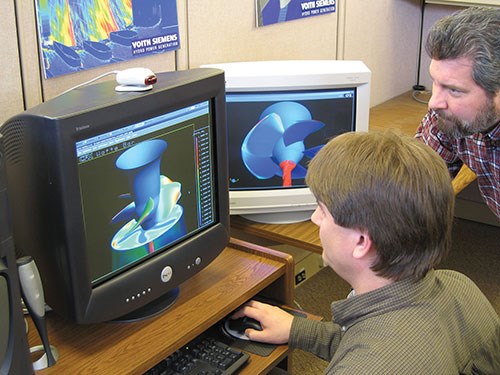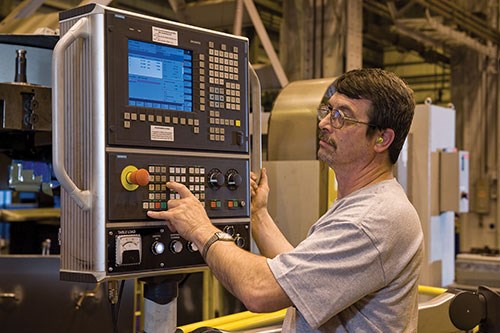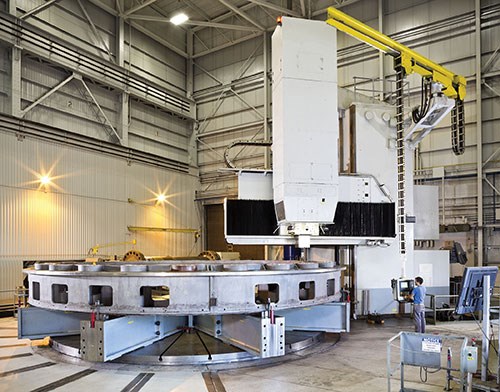Standardized CNC Improves Production of Power-Generation Equipment
Voith Hydro standardized the majority of its machines with a CNC platform from Siemens Industry Inc. to help machine a variety of large, complex parts.
Machining a variety of large, complex parts can lead to a range of challenges, such as troubleshooting maintenance issues and finding employees who are cross-trained to run an assortment of machines. However, Voith Hydro in York, Pennsylvania, has eliminated these challenges with one common machine component—a control from Siemens Industry Inc. (Elk Grove Village, Illinois). By standardizing the CNC platform on the majority of its machines, Voith’s operators can run multiple machines and maintenance time is reduced.
Voith manufactures hydroelectric power generation equipment and intricate turbines for companies and municipalities throughout North America. As a turnkey supplier to the industry, Voith manages all phases of power plant projects, including analysis and planning, design and implementation, and commissioning and operation.
At the York facility, large multi-axis machining centers produce steel and stainless steel workpieces, most often in a one-off mode and at sizes frequently exceeding 35 feet in diameter. In fact, the company can accommodate workpieces measuring more than 42 feet in diameter and weighing more than 350 tons. Surface finishes typically range from 250 to 125 microinch Ra, though occasionally 64 or 32 microinch Ra is required. The finishes are achieved through both machining and secondary finishing operations. Adam Ward, the manager of maintenance and facilities, says the machining typically holds ±0.002-inch tolerances, nonetheless.
According to Mr. Ward, the company is often challenged to design optimum machining cycles for turning, boring and milling these extremely large, heavy and complex workpieces. For example, long cycles can often cause heat to generate in the workpiece and distort it. The deflection of the workpiece can cause imperfections in the finish or even damage it. To minimize such occurrences, Voith uses the Siemens Sinumerik 840D CNC on the majority of its machines. The CNC monitors the workpiece surface orientation to the workpiece as the machine control automatically maintains the optimal cutting path through its spline interpolation capability.
Another benefit of the common Siemens control platform is that the operators are comfortable using it for all motion control, Mr. Ward says. Plus, the operator interface affords troubleshooting capability. For example, when the tool is wearing to such a point that it can compromise the finish, the control automatically detects that condition and alerts the operator and the maintenance department.
Voith’s operators also greatly value the commonality of the human- machine interface (HMI) on the control. When a familiar HMI is present on both a mill and a lathe, operators who might have resisted cross-training are much more cooperative, Mr. Ward says, as the buttons and screen formats are nearly identical. This applies to all levels of the Siemens controls, from the basic three-axis control to the highest-level CNC provided. Once operators learn the specific language of the machine and the programming involved, the interaction with the control is nearly identical. The ability to cross-train is very important to Voith because the one-off nature of the work necessitates operators to be highly flexible. Most of its machine tool operators are capable of running multiple machines, while the maintenance personnel can more easily service the machining equipment throughout the facility, Mr. Ward says.
In a typical manufacturing application, Voith takes a customer design, runs it through the CAM system and simulates the cycle offline to preserve machine uptime. Since the work involves highly complex geometries on the turbine sections, the simulation must be equally complex and account for all machine motions and collision avoidance. Once the program is finally determined for a part, it is fed over the company’s Ethernet network to the appropriate machine tool or machining center for scheduling and production startup.
During production, a system of real-time remote condition monitoring is available through the CNC for troubleshooting by both Voith maintenance personnel and, when required, machine builder personnel working offsite. The reduction in time is substantial when all shop personnel and maintenance people are working in concert to troubleshoot. Usually this occurs in advance of the problem because the condition monitoring on the machine compares actual values of speed, pressure, torque and temperature to preset values. The machine tool builder can track the performance of certain components on the machine. For instance, a motor, bearing, spindle or cutting tool might be wearing faster during machining of harder materials. When the machine can sense this and send the appropriate alerts, the reduction in downtime is substantial. This is a critical factor on such expensive capital equipment, especially given the large volume of one-offs manufactured at Voith.
Specifying Siemens as the control choice for most new machines required at Voith is an easy decision, Mr. Ward says. Aside from the cross-training capability of the CNC, the standardization of the HMI on various types of machines, the support provided and the previous success realized by its operators, maintenance personnel also benefit from the CNC. For instance, when maintenance deals with a control they’ve seen in the past, service time can be substantially reduced. In the case of the Siemens CNC, the maintenance personnel also appreciate the sheer volume of data that can be accessed on the control screen, as well as the onboard troubleshooting manuals. For example, when a drive is sending an off-normal sequence alert, the onboard service manual can quickly identify the problem and suggest remedial action. This reduces the guesswork and saves valuable machine uptime.
In addition, Voith keeps control commonality in mind for machine retrofits. Recently, an Ingersoll milling machine was completely retrofitted both mechanically and electrically with a new CNC, motors, drives, encoders, and other hardware and software by a Siemens Solutions Partner. Often, such complete retrofits can impact the ways and the spindle components on the machines because the motors are faster, the drives are more accurate, the encoders are more precise and the CNC is more powerful. This results in increased speed, something not previously encountered on the machine in its prior condition. When the control can detect excess vibration, wear, temperature or torque spikes, the programming of the cycle steps can be adjusted accordingly. In this case, Voith was able to work with the builder and Siemens support personnel to resolve issues and implement changes to the programming right on the CNC. All of this was done remotely in a short period of time, Mr. Ward says.
Related Content
Generating a Digital Twin in the CNC
New control technology captures critical data about a machining process and uses it to create a 3D graphical representation of the finished workpiece. This new type of digital twin helps relate machining results to machine performance, leading to better decisions on the shop floor.
Read MoreTips for Designing CNC Programs That Help Operators
The way a G-code program is formatted directly affects the productivity of the CNC people who use them. Design CNC programs that make CNC setup people and operators’ jobs easier.
Read MoreImprove Machining Efficiency Through Digital Twin Simulation
Full simulation of a machining cycle using digital twins can not only identify crashes before they happen, but provide insights that enable the user to reduce cycle times.
Read More4 Commonly Misapplied CNC Features
Misapplication of these important CNC features will result in wasted time, wasted or duplicated effort and/or wasted material.
Read MoreRead Next
Registration Now Open for the Precision Machining Technology Show (PMTS) 2025
The precision machining industry’s premier event returns to Cleveland, OH, April 1-3.
Read More5 Rules of Thumb for Buying CNC Machine Tools
Use these tips to carefully plan your machine tool purchases and to avoid regretting your decision later.
Read MoreRego-Fix’s Center for Machining Excellence Promotes Collaboration
The new space includes a showroom, office spaces and an auditorium that will enhance its work with its technical partners.
Read More




















.jpg;maxWidth=300;quality=90)














